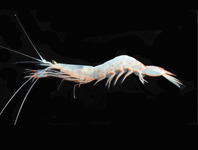Abstract
In the present study we provide evidence for the validity of the genus Trigonodactylus Hass, 1957, improve the diagnosis for this genus and describe a new species that belongs to it—Trigonodactylus persicus sp. nov., from the sand dunes in Khuzestan Province, southwestern Iran. The new species is closely related to Trigonodactylus [Stenodactylus] arabicus sensu Hass, and can be distinguished by the following morphological characteristics: small size, maximum SVL 34 mm; SVL/TailL—approximately 1:1; ventral scales roundish, weakly keeled, 54–61 longitudinal rows at midbody and 190–25 along midbody. No enlarged postmentals. Fingers and toes slightly flattened dorso-ventrally. Lateral edge of digits fringed by series of projecting triangular scales. No web between digits. No preanal and femoral pores. Dorsal color pattern formed by thin, dark, irregular vermicular patches and spots. Sometimes these dark dorsal patterns blend with each other and form transverse bands. There is a narrow, dark, longitudinal line between forelimbs and hindlimbs on lateral sides. Dark, well developed ʌ-shaped marking on snout, which continues behind orbit on tympanum region, approaches the upper ear opening and ends on the pectoral arch. Labial scales white, in some cases with grey-brown dots. Dorsal surfaces of limbs and digits with irregular dark bands. Dorsal surface of tail with 8–10 wide, dark brown bands with irregular margins, same size as alternating light bands. Ventral surface of body and limbs white, tail with dark spots that become more distinct posteriorly.
References
Anderson, S.C. (1999) The Lizards of Iran. In: Contributions to Herpetology. Vol. 15. Society for the Study of Amphibians and Reptiles, Ithaca, New York, pp. 1–442.
Arnold, E.N. (1980) Reptiles of Saudi Arabia: a review of the lizard genus Stenodactylus (Reptilia:Gekkonidae). Fauna Saudi Arabia, 2, 368–404.
Daza, J.D. & Bauer, A.M. (2010) The circumorbital bones of the Gekkota (Reptilia: Squamata). The Anatomical Record, 293, 402–413.
https://doi.org/10.1002/ar.21039Felsenstein, J. (1985) Confidence limits on phylogenies: an approach using the bootstrap. Evolution, 39 (4), 783–791.
https://doi.org/10.1111/j.1558-5646.1985.tb00420.xFujita, M.K. & Papenfuss, T.J. (2011) Molecular systematics of Stenodactylus (Gekkonidae), an Afro-Arabian gecko species complex. Molecular Phylogenetics and Evolution, 58 (1), 71–75.
https://doi.org/10.1016/j.ympev.2010.10.014Haas, G. (1957) Some amphibians and reptiles from Arabia. Proceedings of the California Academy of Sciences, 29, 47–86.
Hartmann, T., Geissler, P., Poyarkov, N.A. Jr., Ihlow, F., Galoyan, E.A., Rödder, D. & Böhme, W. (2013) A new species of the genus Calotes Cuvier, 1817 (Squamata: Agamidae) from southern Vietnam. Zootaxa, 3599 (3), 246–260.
https://doi.org/10.11646/zootaxa.3599.3.3Hebert, P.D.N. & Gregory, T.R. (2005) The promise of DNA barcoding for taxonomy. Systematic Biology, 54, 852–859.
https://doi.org/10.1080/10635150500354886Hillis, D.M., Moritz, C. & Mable, B.K. (1996) Molecular Systematics. 2nd edition. Sinauer Associates, Inc, Sunderland, Massachusetts, xvi + 655 pp.
Huelsenbeck, J.P. & Hillis, D.M. (1993) Success of phylogenetic methods in the four-taxon case. Systematic Biology, 42, 247–264.
https://doi.org/10.1093/sysbio/42.3.247Huelsenbeck, J.P. & Ronquist, F. (2001) MRBAYES: Bayesian inference of phylogeny. Bioinformatics, 17, 754–755.
https://doi.org/10.1093/bioinformatics/17.8.754Jobb, G., von Haeseler, A. & Strimmer, K. (2004) TREEFINDER: a powerful graphical analysis environment for molecular phylogenetics. BMC Evolutionary Biology, 4, 18.
https://doi.org/10.1186/1471-2148-4-18Melnikov, D., Melnikova, E., Nazarov, R., Al-Johany,A. & Ananjeva, N.B. (2015) A new species of Phrynocephalus (Agamidae, Sauria) from Al Sharqiyah sands, northeastern Oman, dedicated to the memory of Sako Tuniyev (1983–2015). Russian Journal of Herpetology, 22 (4), 301–309.
Melnikov, D., Melnikova, E., Nazarov, R.,Rajabizadeh, M., Al-Johany, A., Amr, Z.S. & Ananjeva, N.B. (2014) Taxonomic revision of Phrynocephalus arabicus Anderson, 1984 complex with description of a new species from Ahvaz, South-Western Iran. Russian Journal of Herpetology, 20 (2), 149–159.
Metallinou, M. & Carranza, S. (2013) New species of Stenodactylus (Squamata: Gekkonidae) from the Sharqiyah Sands in northeastern Oman. Zootaxa, 3745 (4), 449‑468.
Metallinou, M., Arnold, E.N., Crochet, P., Geniez, P., Brito, J.C., Lymberakis, P., Baha El Din, S., Sindaco, R., Robinson, M. & Carranza, S. (2012) Conquering the Sahara and Arabian deserts: Systematics and biogeography of Stenodactylus geckos (Reptilia: Gekkonidae). BMC Evolutionary Biology, 12 (258), 1.
https://doi.org/10.1186/1471-2148-12-258Posada, D. & Crandall, K.A. (1998) MODELTEST: testing the model of DNA substitution. Bioinformatics, 14, 817–818.
https://doi.org/10.1093/bioinformatics/14.9.817Ronquist, F. & Huelsenbeck, J.P. (2003) MrBayes 3: Bayesian phylogenetic inference under mixed models. Bioinformatics, 19, 1572–1574.
https://doi.org/10.1093/bioinformatics/btg180Szczerbak, N.N. & Golubev, M.L. (1986) Gekkony Fauny SSSR i sopredelnikh stran [The Gecko Fauna of the USSR and Adjacent Regions]. Nauka Dumka, Kiev, 232 pp., 8 pls. [in Russian]
Smith, A.M., Poyarkov, N.A. Jr. & Hebert, P.D.N. (2008) CO1 DNA barcoding amphibians: take the chance, meet the challenge. Molecular Ecology Notes, 8 (2), 235–246.
https://doi.org/10.1111/j.1471-8286.2007.01964.xSolovyeva, E.N., Poyarkov, N.A., Dunaev, E.A., Duysebayeva, T.N. & Bannikova, A.A. (2011) Molecular differentiation and taxonomy of the sunwatcher toad headed agama species complex Phrynocephalus superspecies helioscopus (Pallas, 1771) (Reptilia: Agamidae). Russian Journal of Genetics, 47 (7), 842–856.
https://doi.org/10.1134/S1022795411070155Swofford, D.L. (1998) PAUP*. Phylogenetic Analysis Using Parsimony (and Other Methods). Version 4. Sinauer Associates, Sunderland, Massachusetts.
Tamura, K., Nei, M. & Kumar, S. (2004) Prospects for inferring very large phylogenies by using the neighbor-joining method. Proceedings of the National Academy of Sciences, 101, 11030–11035.
https://doi.org/10.1073/pnas.0404206101Tamura, K., Stecher, G., Peterson, D., Filipski, A. & Kumar, S. (2013) MEGA6: Molecular Evolutionary Genetics Analysis version 6.0. Molecular Biology and Evolution, 30, 2725–2729.
https://doi.org/10.1093/molbev/mst197

